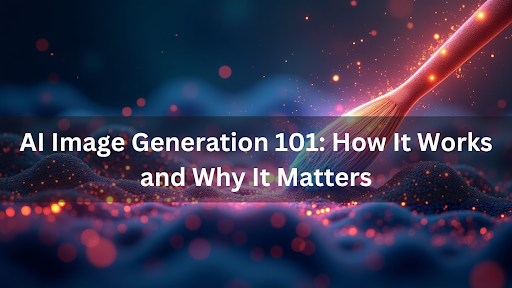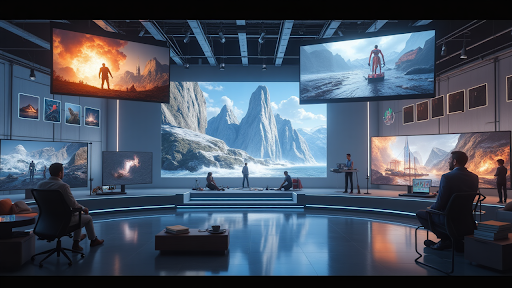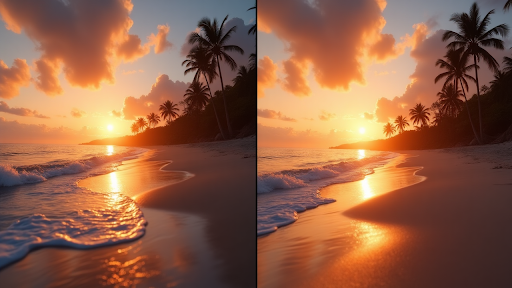AI image generation is changing how we create visuals. It uses algorithms to produce or modify images on the fly. Many industries now rely on AI to design ads, illustrate news, or prototype products.
According to a 2023 report by Grand View Research, the global generative AI market could reach USD 200 billion by 2032. This growth reflects a rising need for fast, custom graphics. In media and marketing, quick visuals are no longer a bonus. They’re essential.
Below is a simple guide to show how AI image generation works, why it matters, and how to get started. You’ll also see its risks and some tips for success.
What You Need to Know
AI image generator goes by many names: generative AI, AI art, or creative AI. All these terms point to the same core concept. Machines learn from huge sets of existing images to create new, convincing ones. Think of it as a digital artist that draws upon millions of samples to craft something fresh.
Many businesses are adopting these tools because they save time and reduce design costs. Designers, marketers, and content creators can skip the hunt for stock photos. Instead, they rely on AI to whip up tailored visuals in seconds.
How AI Image Generation Works
At the heart of AI image generation is pattern recognition. The system “sees” patterns in real images. It then blends or extrapolates those patterns to produce new images. These images can look like photographs, paintings, or abstract designs.
Most AI models do this by breaking down images into complex mathematical representations. Each image becomes a set of features. The model then reassembles those features in new ways, guided by user prompts or random variations.
Key Techniques
- GANs (Generative Adversarial Networks)
GANs are like two players in a game. One, called the generator, tries to create a realistic image. The other, called the discriminator, judges whether the image is real or fake. If the discriminator catches a fake, the generator adjusts its approach. Over many rounds, the generator gets better at tricking the discriminator. This leads to high-quality synthetic images. - Diffusion Models
Diffusion models start with random noise. They then apply a series of steps to shape that noise into an image. Each step refines the details, guided by learned patterns. These models have gained popularity because they excel at producing sharp, detailed images. Some users say they offer more control than GANs. - Transformers or Other Models
Transformers power many modern AI tools, including language models. They can also help generate images. By focusing on attention mechanisms, these models learn complex relationships between pixels. They often work well with text-based prompts. For instance, you might type “A fox wearing a top hat” to get a unique illustration.
Data and Training Process
Data Sourcing
AI models need vast and diverse datasets. These datasets might come from online galleries, archives, or special collections. The quality of this data matters. If the training set is biased or limited, the results will reflect those flaws.
Model Training
Training involves feeding images into the network. Over time, the network refines its parameters to match patterns in that data. This can take hours, days, or even weeks. Cloud computing and specialized hardware speed up the process. After training, the model should produce images similar to those in its dataset, yet still new and unique.
Why It Matters
Industry Impact
- Business & Marketing
AI image generation saves time. Brands can ask an AI to produce a dozen ad concepts instead of hiring a large creative team. According to a McKinsey study, companies using AI in marketing can see a 15-20% jump in ROI from faster and more targeted ad creation. - Entertainment & Media
Movies, TV shows, and games rely on concept art. AI can generate these designs at scale, which helps studios iterate faster. In 2022, major studios used AI for storyboarding and pre-visualization, cutting down on months of production time.
Creative and Practical Benefits
- Efficiency Gains
AI reduces repetitive design tasks. If you need a simple background or a style variation, AI can produce it in moments. Designers can then focus on higher-level work. A study by Adobe found that 59% of creative professionals use some form of AI to streamline workflows. - Endless Possibilities
AI isn’t limited by the same constraints as human artists. It can mix styles—think “Van Gogh meets comic art”—in a way that might take a real person much longer. This leads to bold designs that challenge creative norms.
Practical Use Cases
Content Creation
- Blog & News Illustrations
Online publishers thrive on quick visuals. AI tools can generate custom images for breaking stories. That’s faster than searching stock photo sites. It also adds a fresh look that aligns with the article’s theme. - Social Media Thumbnails
Thumbnails should grab attention right away. AI can produce countless variants to test for click-through rates. Instead of paying for multiple designs, you get many for the price of one tool.
Marketing & Advertising
- Product Mockups
Marketers often need to show products in different settings. AI can place a product in a jungle, a sci-fi city, or a cozy bedroom with minimal input. This helps potential customers see the product’s versatility. - Personalized Ads
Personalization boosts sales. AI can generate images that cater to specific demographics. For example, an outdoor gear brand can show hikers on rugged trails to adventurous customers, while offering cozy winter scenes to families.
Design & Prototyping
- Concept Art
Game designers and filmmakers explore many visions before finalizing a look. AI can sketch these visions in minutes. This lets creators pivot faster if a concept fails to excite. - User Experience Demos
Apps and websites might need mock screens. AI can generate placeholder images that look polished. These add realism to early demos without hiring a photographer or graphic artist.
Risks & Limitations
Ethical Concerns
- Copyright & Ownership
AI outputs can mimic human creations. It’s unclear who owns the rights in certain regions. Recent court cases question whether AI art can be copyrighted at all. Experts say a legal framework could take years to sort out. - Bias & Representation
AI learns from data. If that data isn’t diverse, the results can skew or exclude certain groups. This raises social and ethical questions. For instance, some facial recognition tools perform poorly on darker skin tones due to limited training data.
Quality & Reliability
- Artifact Risks
AI-generated images sometimes include glitches. Eyes might look mismatched. Hands might have six fingers. These errors happen when the model doesn’t generalize well. - Need for Human Oversight
AI can’t gauge context or brand voice like a human can. An expert eye ensures quality. Always review final images. Automated tools are good, but not perfect.
Getting Started
Tools & Resources
- Beginner-Friendly Platforms
Services like DALL·E, Midjourney, and Stable Diffusion are popular. They let you type in text prompts and see instant results. Many have free trials, so you can test them without big costs. - Prompt Crafting Tips
Be specific. If you want a cat wearing a wizard hat, say so. Mention styles or color palettes. Instead of “cool picture of a cat,” say “hyper-realistic cat wearing a blue wizard hat in a fantasy forest.” That detail guides the AI toward the desired output.
Prompt Crafting Example
- Weak Prompt: “Ocean view at sunset”
- Strong Prompt: “Stunning seaside view at golden-hour sunset with crashing waves and palm trees, in the style of digital matte painting.”
The second prompt adds detail. It gives the model context and a stylistic cue.
Conclusion
AI image generation is an evolving field. It leverages massive datasets and smart algorithms to produce new, striking visuals. The benefits are clear: efficiency, cost savings, and creative flexibility. Many industries, from marketing to film, already use it to speed up workflows.
Still, risks exist. Ethical and legal issues are in flux. Models can produce bias or inaccurate images. They also need expert curation to ensure brand fit and quality. Yet the potential is too big to ignore.
If you’re curious, test an entry-level platform. Start with a simple prompt and refine until you get something you like. Over time, you’ll learn to guide the AI for consistent, appealing results. That’s the heart of AI image generation: a collaborative dance between human imagination and machine precision.









